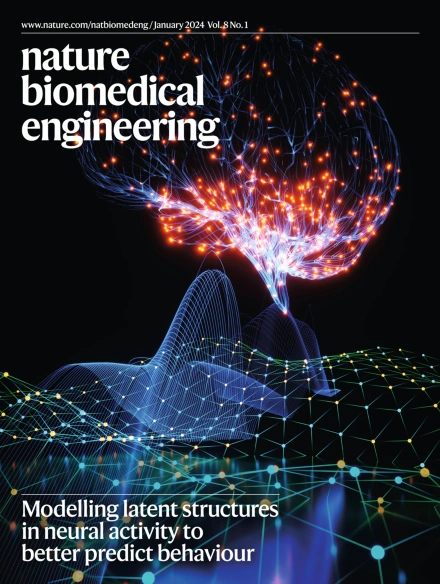Implanted microelectrode arrays in reinnervated muscles allow separation of neural drives from transferred polyfunctional nerves.
IF 26.8
1区 医学
Q1 ENGINEERING, BIOMEDICAL
引用次数: 0
Abstract
Targeted muscle reinnervation surgery reroutes residual nerve signals into spare muscles, enabling the recovery of neural information through electromyography (EMG). However, EMG signals are often overlapping, making the interpretation of limb functions complicated. Regenerative peripheral nerve interfaces surgically partition the nerve into individual fascicles that reinnervate specific muscle grafts, isolating distinct neural sources for precise control and interpretation of EMG signals. Here we combine targeted muscle reinnervation surgery of polyvalent nerves with a high-density microelectrode array implanted at a single site within a reinnervated muscle, and via mathematical source separation methods, we separate all neural signals that are redirected into a single muscle. In participants with upper-limb amputation, the deconvolution of EMG signals from four reinnervated muscles into motor unit spike trains revealed distinct clusters of motor neurons associated with diverse functional tasks. Our method enabled the extraction of multiple neural commands within a single reinnervated muscle, eliminating the need for surgical nerve division. This approach holds promises for enhancing control over prosthetic limbs and for understanding how the central nervous system encodes movement after reinnervation.植入微电极阵列在再神经支配的肌肉可以分离神经驱动从转移的多功能神经。
定向肌肉神经移植手术将残留的神经信号转移到备用肌肉中,通过肌电图(EMG)恢复神经信息。然而,肌电图信号经常重叠,使得肢体功能的解释变得复杂。再生的周围神经接口通过手术将神经分割成单独的神经束,这些神经束可以支配特定的肌肉移植物,从而分离出不同的神经来源,以精确控制和解释肌电图信号。在这里,我们将多价神经的靶向肌肉再神经移植手术与高密度微电极阵列植入再神经肌肉的单个部位相结合,并通过数学源分离方法,我们分离了所有重定向到单个肌肉的神经信号。在上肢截肢的参与者中,将来自四个再神经支配肌肉的肌电图信号反卷积到运动单元尖峰序列中,揭示了与不同功能任务相关的不同运动神经元簇。我们的方法能够在单个再神经支配肌肉中提取多个神经指令,从而消除了手术神经分裂的需要。这种方法有望增强对假肢的控制,并有助于理解中枢神经系统如何在神经移植后对运动进行编码。
本文章由计算机程序翻译,如有差异,请以英文原文为准。
求助全文
约1分钟内获得全文
求助全文
来源期刊

Nature Biomedical Engineering
Medicine-Medicine (miscellaneous)
CiteScore
45.30
自引率
1.10%
发文量
138
期刊介绍:
Nature Biomedical Engineering is an online-only monthly journal that was launched in January 2017. It aims to publish original research, reviews, and commentary focusing on applied biomedicine and health technology. The journal targets a diverse audience, including life scientists who are involved in developing experimental or computational systems and methods to enhance our understanding of human physiology. It also covers biomedical researchers and engineers who are engaged in designing or optimizing therapies, assays, devices, or procedures for diagnosing or treating diseases. Additionally, clinicians, who make use of research outputs to evaluate patient health or administer therapy in various clinical settings and healthcare contexts, are also part of the target audience.
 求助内容:
求助内容: 应助结果提醒方式:
应助结果提醒方式:


